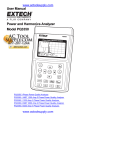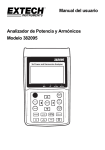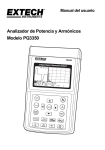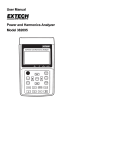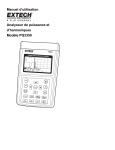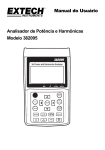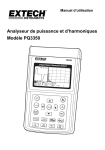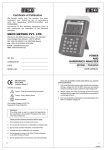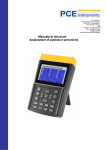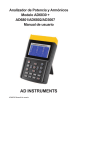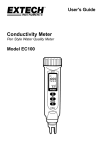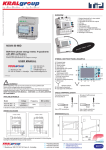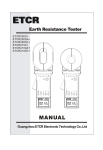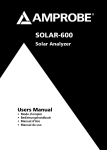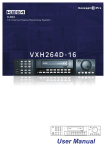Download User Manual Power and Harmonics Analyzer Model PQ3350
Transcript
User Manual Power and Harmonics Analyzer Model PQ3350 EN 61010-2-032 CAT III 600V Pollution Degree 2 Definition of Symbols: Caution: Refer to Accompanying Documents Caution: Risk of Electric Shock Double Insulation Over-voltage category III (CAT III): equipment in fixed installations. WARNING: If the power analyzer is used in a manner not specified by the manufacturer, the protection provided by the clamp meter may be impaired. Please read the following instructions before use 1. Do not operate this instrument in wet or dusty environments. 2. Do not operate this instrument in the presence of combustible or explosive gas 3. Do not touch exposed metal parts or unused terminals. 4. Consider the use of rubber gloves in operation. 5. Do not operate in excess of AC 500V (Phase to Neutral), or AC 600V (Phase to Phase) 6. Do not operate this instrument if it appears to be malfunctioning 1. Do not install the flexible current probe around bare conductors carrying a voltage from Do not use the flexible current probe before reading the following instructions. 30V to 600V unless you are wearing protective clothing and glove suitable for high-voltage work. 2. Always inspect and check for any damage of the current probe assembly before usage. 3. Do not use the flexible current probe on circuit rated higher than 600V in installation Do not use the flexible current probe if any damage is found. category III. 2 PQ3350 V5.2 11/10 Table of Contents Preparation for use ..................................................................................................... 11 Power Quality of a 3 Phase 4 Wire (3P4W) System ................................................12 Power Quality of a 3 Phase 3 Wire (3P3W) System ................................................13 Power Quality of a Single Phase (1P2W) System....................................................14 Power Quality of a 1 Phase 3 Wire (1P3W) System ................................................15 Measurement of a System with CT or VT (PT) .......................................................16 Harmonic Analysis of Voltage or Current.................................................................17 Display the Phase Angle of Harmonics ....................................................................18 Measurement of Maximum Demand .......................................................................19 Waveform of Voltage and Current ............................................................................19 Waveform for Voltage Only ......................................................................................20 Graphic Phase Diagram.............................................................................................20 Phase Sequence of a 3 Phase System........................................................................22 Balanced and Unbalanced 3 Phase (3P3W, 3P4W) Power Source System............22 Balanced and Unbalanced 3 Phase (3P3W or 3P4W) Load System ......................23 Transient Capture (Dips, Swells, Outage).................................................................24 Down Load Transient Data .......................................................................................26 Datalogging Power Data (3P4W, 3P3W, 1P2W, 1P3W).........................................26 Down Load Power Data............................................................................................26 Data Logging Harmonics Data .................................................................................27 Down Load Harmonics Data ....................................................................................27 Clear Memory of Data...............................................................................................27 HardCOPY of SCREEN ...........................................................................................28 READ the SAVED SCREEN...................................................................................29 SET THE CT AND VT (PT) RATIO.......................................................................30 SET THE TIME INTERVAL FOR MAXIMUM DEMAND...............................31 SET THE SAMPLING TIME FOR DATA LOGGING ........................................32 SET THE CALENDER CLOCK ............................................................................33 PROTOCOL (RS-232C INTERFACE)...................................................................33 SPECIFICATIONS (23°C± 5°C) .......................................................................34 3 PQ3350 V5.2 11/10 FEATURES ■ Analysis for 3P4W, 3P3W, 1P2W, 1P3W ■ True RMS value (V123 and I123) ■ Active Power (W, KW, MW, GW) ■ Apparent and Reactive Power (KVA, KVAR) ■ Power Factor (PF), Phase Angle (Φ) ■ Energy (WH, KWH, KVARH, PFH) ■ Current measurement from 0.1mA to 3000A, capable of analyzing IT standby power consumption to the maximum demand of a factory ■ Display of 35 Parameters in One Screen (3P4W) ■ Programmable CT (1 to 600) and PT (1 to 3000) Ratios ■ Display of Overlapped Voltage and Current Waveform ■ Maximum Demand (MD KW, MW, KVA, MVA) with Programmable Period ■ Harmonic Analysis (V123 and I123) to the 99th Order ■ Display of 50 Harmonics in one Screen with Waveform ■ Display of Waveform with Peak Values (1024 Samples / Period) ■ Analysis of Total Harmonic Distortion (THD-F) ■ Graphic Phase Diagram with 3 Phase System Parameters ■ Capture 28 Transient Events (Time + Cycles) with Programmable Threshold (%) ■ DIP, SWELL, and OUTAGE are included in transient events. ■ 3 Phase Voltage or Current Unbalanced Ratio (VUR, IUR) ■ 3 Phase Voltage or Current Unbalanced Factor (d0%, d2%) ■ Calculated Unbalanced Current through Neutral Line (In) ■ 512K Memory with Programmable Interval (Sampling time from 2 to 6000 seconds, data logging time from 4.7 hours to 1180 days for 3P4W system) ■ Output of Waveform, Power Parameters and Harmonics on Command ■ Large Dot Matrix LCD Display with Backlight ■ Optical Isolated RS-232C Interface 4 PQ3350 V5.2 11/10 PANEL DESCRIPTION 1 2 V2 V1 POWER I1 V3 I3 I2 4 3 5 6 7 8 9 12 10 5 11 PQ3350 V5.2 11/10 Panel Description 1. Input Terminal for Neutral Line (Voltage) 2. Voltage Input Terminals for Each Phase (V1, V2, V3) 3. External DC Input (The AC adaptor must be 600V isolated) 4. Current Input Terminals for Each Phase (I1, I2, I3) 5. LCD Display 6. Indication of locations where SEC., CT, VT, and SETUP are displayed in LCD. 7. Buttons 8. RS-232C Window 9. Stand Holder 10. Stand 11. Battery Cover 12. Battery Compartment Press this button to exit transient detection mode. Also used to exit the SETUP menu Press this button to perform transient detection Press this button to hold the data displayed in LCD, press again to continue operation. Press this button to begin the measurement of harmonics in magnitude. Press this button to select V1, I1, V2, I2, V3, or I3 for harmonics analysis 6 PQ3350 V5.2 11/10 Press this button for the voltage or current input range Press to enter the Main Menu (also used to navigate menu items). Press this button to increment value by one. Hold the button for two seconds or more to speed up the increment. Press this button to decrement value by one. In harmonic analysis mode, use these buttons to move the cursor left or right. Press this button to start data logging. Press it again to stop data logging. The sampling interval is displayed in the LCD via the SEC indicator. In the power mode, press this button to display the phase. In the harmonic analysis mode, press this button to display phase angle instead of magnitude. Press this button to turn the back light on. Press it again to turn the back light off. Press this button to begin measuring power. Press this button to display the waveforms for voltage and current. Press this button to display the waveform for voltage only In the power mode, press this button to select the appropriate system (3P4W, 3P3W, 1P2W or 1P3W). In the waveform mode, press to select (V1, I1), (V2, I2), or (V3, I3). Press this button to turn the power on or off. 7 PQ3350 V5.2 11/10 Current Probe (100A) WARNING: All the current probes connected to the power analyzer must be of the same model and same range. Mixed models and different ranges selected will cause incorrect result of measurement. 1. Jaw Assembly 2. Trigger 3. Range Selector 4. 6 pin mini DIN connector 100A 100A (HARMON) 100A (POWER) 60A 10A (HARMON) 10A 1A 1A NOTE: To choose the 100A current probe, press the SETUP button to select CLAMP. When the CLAMP is reverse video, press the ▲ or ▼ button to select 100. Current Probe (1000A) 1. Jaw Assembly 2. Trigger 3. Range Selector 4. 6 pin mini DIN connector 1000A 100A 10A NOTE: To select the1000A current probe, press the SETUP button to select CLAMP. When the CLAMP is reverse video, press the ▲ or ▼ button to select 1000. 8 PQ3350 V5.2 11/10 Flexible Current Probe (3000A or 1200A) 1. Control Box 2. Output Range Select Switch 3. Flexible Loop 4. Coupling Assembly 1 2 3 4 NOTE: To select the 3000A flexible current probe, press the SETUP button to select CLAMP. When the CLAMP is reverse video, press the ▲ or ▼ button to select 3000. NOTE: To select the 1200A flexible current probe, press the SETUP button to select CLAMP. When the CLAMP is reverse video, press the ▲ or ▼ button to select 1200. WARNING: All the current probes connected to the power analyzer must be of the same model and same range. Mixed models and different ranges will yield incorrect measurement results. 9 PQ3350 V5.2 11/10 OPERATING INSTRUCTIONS NOTE: Pay special attention to the flexible current probe connecions. 1. Connect the flexible probe around the conductor. 2. Make sure the current flowing direction is in consistent with the arrow marked on the probe coupling. If the flexible current probe is connected in the right orientation, the correct phase will be displayed in the oscilloscope. 3. Keep the probe coupling more than 25mm away from the conductor. WARNING: Always wear appropriate gloves in operation. NOTE: Select the correct CLAMP in the SETUP menu. When the current probe is connected to the power analyzer, the power analyzer will automatically detect the range selected. NOTE: Select the correct frequency (Hz) in the SETUP menu. 10 PQ3350 V5.2 11/10 Preparation for use 1 2 3 4 5 6 7 8 9 10 11 12 a. 13 14 15 16 17 Press SETUP button to enter setup screen. Press SETUP again to select the item for setting (the selected item will be displayed in reverse video). After selecting the item, press ▲ or ▼ buttons to set up its value. b. After finishing setting up, press EXIT button to leave setup mode. 1. Select the data for download: H means harmonics; H in reverse video means HOLD screen data (if the data is the one you want, you can press HOLD button to display the data, and press HOLD button again to exit); P means power data which can be a reference for downloading, the data in order is 0~84. 2. Shows the total logged data in the analyzer: max. 85 logging data. st 3. REC DATE: shows the starting logging time of the 1 downloaded file. 4. Hz: set up the frequency (50, 60 or AUTO) of the system. 5. PT: set up PT value. 6. CT: set up CT value. 7. SEC: set up the interval seconds of logged data. 8. CLAMP: set up the clamps selected (100A, 1000A or 3000A). 9. MD TIME: set up the time of Maximum Demand (1~60 minutes). 10. TRANS REF: set up the transient voltage (which will be automatically changed in accordance with PT). 11. SDVP: set up upper and lower limits % of transient voltage detection. 12. YEAR: Set up “year” of calendar clock. 13. MONTH: Set up “month” of calendar clock. 14. DATE: Set up “date” of calendar clock. 15. HOUR: Set up “hour” of calendar clock. 16. MINUTE: Set up “minute” of calendar clock. 17. SECOND: Second can be displayed only (it can not be adjusted). 11 PQ3350 V5.2 11/10 Power Quality of a 3 Phase 4 Wire (3P4W) System a. Turn the power on. Press the POWER and the 1Φ3Φ buttons to select the 3P4W system. The type of system will be displayed at the left bottom corner in the LCD. b. Connect the four test leads to the voltage terminals V1, V2, V3 and the VN (Neutral) of the system. c. Connect the test leads to L1, L2, and L3 of the 3P4W system. d. Connect the three current probes to the power analyzer input terminal I1, I2, and I3. e. Clamp on to the L1, L2, and L3 of the 3P4W system. Make sure the current flows from the front of the current probe to the back. f. All of the system parameters will be shown in the LCD For a description of each parameter, refer to section XIV. NOMENCLATURE. 12 PQ3350 V5.2 11/10 Power Quality of a 3 Phase 3 Wire (3P3W) System a. Turn the power on. Press the POWER and the 1Φ3Φ buttons to select the 3P3W system. The type of system will be displayed at the bottom right of the LCD. b. Connect the four test leads to the voltage terminals L1, L2, and L3 of the system. c. Connect the three current probes to the power analyzer input terminal I1, I2, and I3. d. Clamp on to the L1, L2, and L3. Make sure the current flows from the front of the current probe e. All parameters of the system will be shown in the LCD to the back. For a description of each parameter, refer to XIV. NOMENCLATURE. 13 PQ3350 V5.2 11/10 Power Quality of a Single Phase (1P2W) System a. Press POWER and then 1Φ3Φ to select the 1P2W system. The type of system will be b. Connect the test leads to the voltage terminals L1 and VN (Neutral) of the system. displayed at the bottom right of the LCD c. Connect one current probe to the power analyzer input terminal I1. d. Clamp on to the L1. Make sure the current flows from the front of the current probe to the back (see arrow labeled on clamp probe). e. All of the parameters of the system will be shown in the LCD For a description of each parameter, refer to XIV. NOMENCLATURE. 14 PQ3350 V5.2 11/10 Power Quality of a 1 Phase 3 Wire (1P3W) System a. Turn the power on. Press the POWER and the 1Φ3Φ buttons to select the 1P3W system. The type of system will be displayed at the bottom right of the LCD. b. Connect the test leads to the voltage terminals L1, L2 and VN (Neutral) of the system. c. Connect the two current probes to the power analyzer input terminal I1 and I2. d. Clamp on to the L1 and L2. Make sure the current flows from the front of the current probe to e. All of the system parameters will be shown in the LCD the back. For a description of each parameter, refer to XIV. NOMENCLATURE. 15 PQ3350 V5.2 11/10 Measurement of a System with CT or VT (PT) a. Turn the power on. Press the POWER and the 1Φ3Φ buttons to select the 3P4W system. The type of system will be displayed at the bottom right of the LCD. b. Connect the four test leads to the secondary voltage terminals L1, L2, L3 and the VN (Neutral) of the system. c. Clamp on to the secondary coils of L1, L2, and L3. Make sure the current flows from the front of the current probe to the back (see the arrow label on the clamp probe). d. Press SETUP to enter the SETUP menu. e. Press SETUP several times until the CT symbol is highlighted. f. Press the ▲ or ▼button to increment or decrement the RATIO specified by the CT. 16 PQ3350 V5.2 11/10 g. Press the SETUP button several times until the VT symbol is highlighted. h. Press the ▲ or ▼button to increment or decrement the RATIO specified by the VT. i. All 35 system parameters will be shown in the LCD For a description of each parameter, refer to XIV. NOMENCLATURE. Harmonic Analysis of Voltage or Current (Normal Voltage without Distortion and Harmonics) (Distorted Current with Harmonics) a. Setup the analyzer for measurement of any power system (3P4W, 3P3W, 1P2W, or 1P3W). To view 17 PQ3350 V5.2 11/10 the harmonic analysis of voltage or current, press the HARMO button. b. Once the HARMO button is pressed, the waveform will be shown in the left-hand portion of the LCD, st th and the 1 to 50 order harmonics will be shown in the right-hand portion of the LCD. c. The positive and negative peak values will be shown in the waveform (Vpk). d. The true RMS value & total harmonic distortion of voltage or current is shown under the waveform. e. The cursor (↑arrow) will point to the current order of harmonics. The frequency (HZ) will be displayed next to the cursor. The percentage of harmonics (%) will be displayed below the cursor. The magnitude of the harmonics (V or A) or phase angle will be displayed next to the %. f. Press the SETUP button several times until HAR is highlighted. g. To move the cursor to the next harmonic, use the ◄or ► button. st th th h. To see the next page (51 to 99 order) press the ► button to pass the 50 order or press the ◄ st button to pass the 1 order. NOTE: If the waveform is clipped at the peak or too small in the LCD, press the RANGE button to select HIGH or LOW range for a better display. The range indicator is the symbol after the unit of RMS value, L or H. Display the Phase Angle of Harmonics When the HARMO button is pressed the magnitude of each harmonic is displayed. To review the phase angle of each harmonic, press the PHASE button. The phase angle will be displayed next to the % display icon. V1 does not trigger at exactly 0 degrees; it may be a few degrees after ‘0’. The remaining signals (V2, V3, I1, I2, I3) are sampled when V1 is triggered. In other words, the phase angles for V2, V3, I1, I2, and I3 are sampled with respect to V1. For example, if V1, I1 have a phase difference of 30 degrees, they are displayed as V1 (2 degrees), I1 (32 degrees) in the harmonics analysis. NOTE: If the waveform is clipped at the peak or too small in the LCD, press the RANGE button to select HIGH or LOW range for a better display. The range indicator is the symbol after the unit of RMS value, L or H. 18 PQ3350 V5.2 11/10 Measurement of Maximum Demand 1. Set the time interval for maximum demand (refer to section V) 2. The analyzer will integrate the KW and KVA over the specified interval. 3. The maximum demand (MD) updates if new demand is greater than the previous value. In the following example, the maximum demand is 527.4VA and 527.4W. The time interval for maximum demand is 2 minutes. Waveform of Voltage and Current Press this button to display the waveforms for voltage and current simultaneously. Press this to select different inputs (V1, I1), (V2, I2), or (V3, I3). NOTE: The triggering point is the zero crossing point of V1 for V2, V3, I2, and I3. The triggering point for I1 is its own zero crossing point in case V1 is not present. NOTE: In the waveform display mode, one period/cycle of 1024 data points is displayed. 19 PQ3350 V5.2 11/10 Waveform for Voltage Only Press this button to display the voltage waveform only. The true RMS value of voltage will be displayed at the bottom of the LCD. Press this button to select V1, V2, or V3. NOTE: The triggering point is the zero crossing point of V1 for V2 and V3. NOTE: In the waveform mode, one period/cycle of 1024 data points is displayed. Graphic Phase Diagram Press this button to display the phase diagram. The voltage and current signals are displayed in phase format (magnitude, angle). 20 PQ3350 V5.2 11/10 V1 is the reference. The V1 angle is always 0 degrees. The phase angles of V2, V3, I1, I2, and I3 are displayed with respect to V1. V1, V2, V3, I1, I2, I3, V12, V23, and V31 are displayed in vector form graphically. V1, V2, V3: Phase voltages in phase format with respect to V1 I1, I2, I3: Line currents in phase format with respect to V1. IVn: Calculated voltage and current of the neutral with respect to ground. V12, V23, V31: Line voltage in phase format with respect to V1. Ave: Average of line voltage V12, V23, and V31 and line current I1, I2, and I3 dV%: Historical maximum % value of (Max (V1, V2, V3) – Min (V1, V2, V3)) / Min (V1, V2, V3) * 100% VUR: Voltage (Unbalanced Ratio) d02: The first number is Zero Sequence Unbalanced Ratio in % (d0) of voltage; the second number is the Negative Sequence Unbalanced Ratio in % (d2) of voltage. When VUR is displayed before d02, d02 represents the Zero and Negative Sequence Unbalanced Ratios for voltage. REF: nominal voltage for transient detection reference Sd%: threshold in % for transient detection with respect to nominal voltage (REF). NOTE: The phase is drawn only when the reading exceeds 200 counts. If V is zero, the phase of the current will not be drawn. Press this button to change the display from VUR to IUR dA%: Historical max % value of (Max (I1, I2, I3) – Min (I1, I2, I3) ) / Min (I1, I2, I3) * 100% IUR: Current Unbalance Ratio d02: The first number is Zero Sequence Unbalanced Ratio in % (d0) for current; the second number is the Negative Sequence Unbalanced Ratio in % (d2) for current. When IUR is displayed before d02, d02 represents the Zero (d0) and Negative (d2) Sequence Unbalanced Ratios for current. REF: Nominal voltage for transient detection reference Sd%: Threshold in % for transient detection with respect to nominal voltage (REF). 21 PQ3350 V5.2 11/10 NOTE: If the voltage of L1, L2, and L3 is not connected in the correct sequence, the analyzer will show L1-3-2 in the right top corner, and it will beep to warn of an incorrect phase sequence. Phase Sequence of a 3 Phase System Press this button to display the phase diagram. In this mode, the analyzer also detects the phase sequence. If the voltage of L1, L2, and L3 is not connected in the correct sequence, the analyzer will show L1-3-2 in the right top corner, and it will beep to warn of an incorrect phase sequence. Balanced and Unbalanced 3 Phase (3P3W, 3P4W) Power Source System In order to check if a system is balanced, press this button to display the phase diagram along with the VUR. Balanced System If a 3 phase power source system is balanced, the parameters should be as follows: V1 = V2 = V3 V12 = V23 = V31 The phase angle of V2 = -120; the phase angle of V3 = 120 22 PQ3350 V5.2 11/10 Vn (voltage of neutral with respect to ground) = 0V VUR = 0% d0% = 0% d2% = 0% Unbalanced Systems If the values differ from the numbers above, an unbalanced power source system may be the reason. The magnitude of the differences can be used as an indication of an unbalanced power source system. The larger the difference, the further unbalanced the system will be. Balanced and Unbalanced 3 Phase (3P3W or 3P4W) Load System In order to check if current of a system is balanced, press the button twice to display the phase diagram with the IUR displayed. Balanced System If a 3 phase load system is balanced, the parameters should be as follows: I1 = I2 = I3 The phase angle for I2 and I1 (I2 ± I1) = ±120 The phase angles of I3 and I2 (I3 ± I2) = ±120 In (current of neutral) = 0A IUR = 0% d0% = 0% d2% = 0% Unbalanced Systems If the values differ from the numbers above, an unbalanced load system may be the reason. The magnitude of the difference can be used as an indication of an unbalanced power source system. The larger the difference, the more unbalanced the load will be. 23 PQ3350 V5.2 11/10 Transient Capture (Dips, Swells, Outage) 1. Press to enter the PHASE DIAGRAM mode. 2. Press the SETUP button until TRANS REF in reverse video is shown in the LCD. 3. Press the ▲ or ▼ button to increment or decrement the nominal voltage for a reference. To exit, press the EXIT button. 4. Press the SETUP button several times until SDVP is shown in the right bottom corner of the LCD. 5. Press the ▲ or ▼ button to increment or decrement the threshold in % (SDVP). To exit, press the 24 PQ3350 V5.2 11/10 EXIT button. 6. Press the TRANSIENT button to start the “Transient Capture” 7. The backlight will switch off when the TRANSIENT button is pressed. 8. If the analyzer captures any transient events (DIP, SWELL, or OUTAGE), the backlight will switch on. Press the TRANSIENT button to review the recorded TRANSIENT events. 9. To exit TRANSIENT CAPTURE, press the EXIT TRANSIENT button. Definition of SWELL, DIP, and OUTAGE: SWELL: VRMS > [VREF + (VREF * SD%)] Code for SWELL: 1 If the true RMS value of either phase (V1, V2, or V3) rises above the nominal value plus the threshold (REF + SD%), it is regarded as SWELL. Code for SWELL is 1. DIP: VRMS < [VREF – (VREF * SD%)] Code for DIP: 2 If the true RMS value of either phase (V1, V2, or V3) falls below the nominal value plus the threshold, it is regarded as DIP. The code for DIP is 2. OUTAGE: VRMS < 30 to 40V Code for OUTAGE: 4 If the true RMS value of either phase is less than 30 to 40V, it is regarded as OUTAGE. The code for OUTAGE is 4. Code Table: CODE SWELL 1 DIP 2 OUTAGE 4 COMMENT Codes can be added together DISPLAY FORMAT: First column: Sequential number of events. Second column: Elapsed time (the elapsed time format is DAYS, HOURS, MINUTES) 99 days 24 hours 60 minutes max The third column: Number of cycles. The fourth column: Code of transient events. There can be more than one transient condition occurring in one event. NOTE: In the TRANSIENT CAPTURE mode, the analyzer takes 128 samples of each cycle for each phase continuously. NOTE: When the user presses the TRANSIENT button to review the recorded events, the capture operation is paused until TRANSIENT is pressed again. The timer is also stopped when TRANSIENT is pressed. Therefore, the time stamp is not correct when the user presses the TRANSIENT button to resume operation. NOTE: The analyzer can record up to 28 events. When the analyzer has recorded 28 events, it stops the capture operation, turns the backlight on, and displays the 28 transient events. NOTE: The codes can be summed to indicate two or three conditions. For example, if the code is 6, DIP and OUTAGE (2+4) have been added. NOTE: The longest duration for a capture operation is 99 days. Use the external 12V DC power adaptor for long capture operation. WARNING: Select 50 or 60 Hz for transient capture. If AUTO is selected for frequency, the unit will not 25 PQ3350 V5.2 11/10 allow entrance to the TRANSIENT capture mode (an audible beep will sound). Down Load Transient Data When the TRANSIENT button is pressed to display CAPTURED EVENTS, the data is also output through the RS-232 interface simultaneously. The data output is in the same format as the LCD display format (ASCII) YEAR MONTH DAY HOUR MINUTE SECOND CT REF CODE 01 ELAPSED_TIME CYCLES CODE 02 ELAPSED_TIME CYCLES CODE 03 ELAPSED_TIME CYCLES CODE 04 ELAPSED_TIME CYCLES CODE Datalogging Power Data (3P4W, 3P3W, 1P2W, 1P3W) 1. Set the datalogger sampling time (rate) 2. Press the POWER button to enter the power measurement mode. 3. Press the 1Φ3Φ button to select the appropriate system (3P4W, 3P3W, 1P3W, or 1P2W). 4. Press the REC button to start logging. A REC symbol will display. 5. To stop logging, press the REC button again. NOTE: To download data, send a CTRL+D command to the analyzer through RS-232C interface. WARNING: The sampling time could be longer than the set value if there is no input at V1. Down Load Power Data 1. Press the SETUP button. 2. “Down Load File” will be shown in reverse video. 3. Press the ▲ or ▼ button to select the file number. 4. If the data stored in a selected file is power data, a leading symbol “P” will precede the file name 5. Press the EXIT button. 6. When a CTRL D command is received through the RS-232C port, it downloads stored power data. NOTE: In the setup mode, the unit will not accept commands through the RS-232C port. To down load data, press the EXIT button to return to normal measurement mode. 26 PQ3350 V5.2 11/10 Data Logging Harmonics Data 1. Set the sampling time (rate) for data logging 2. Press the HARMO button to enter the harmonics measurement mode. 3. Press the VI button to select the desired input (V1, I1, V2, I2, V3, or I3). 4. Press the REC button to start data logging. A REC symbol will be displayed at the bottom of the LCD. 5. To stop data logging, press the REC button again. WARNING: If there is no input at V1, the sampling rate could be longer than the programmed value. Down Load Harmonics Data 1. Press the SETUP button. 2. “Down Load File” will be shown in reverse video. 3. Press the ▲ or ▼ button to select the file number. 4. If the data stored in a selected file is harmonics data, a leading symbol “H” will precede the file name. 5. Press the EXIT button. 6. When the unit receives a CTRL D command through the RS-232C port, it will down load previously saved harmonic data. NOTE: In the setup mode, the unit will not accept any commands through the RS-232C port. To down load data, press the EXIT button to return to normal measurement mode. Clear Memory of Data To clear all data memory of the unit, hold the REC button and turn the power on. 27 PQ3350 V5.2 11/10 HardCOPY of SCREEN 1. Press the HOLD button. 2. Press the REC button. It takes a few seconds to hardcopy the screen, and store the screen in an internal file. The LCD will show REC in reverse video when in operation. The number following REC is the file number. 3. Users can store up to 85 screens (if no power or harmonics data is stored). 28 PQ3350 V5.2 11/10 READ the SAVED SCREEN 1. Press the SETUP button. ‘DOWN LOAD FILE’ is displayed in reverse video. If the data in the selected file is a hardcopy of the screen, a leading symbol of H is displayed in reverse video. 2. Press the ▲ or ▼ to select the saved screen. 3. Press the HOLD/READ button to restore the saved screen. NOTE: If the data saved in a specific file is a HARDCOPY of a screen, a leading symbol of H is displayed in reverse video. NOTE: Hardcopy data can not be downloaded. 29 PQ3350 V5.2 11/10 SET THE CT AND VT (PT) RATIO Press the SETUP button several times until CT or VT is shown in reverse video. Press the ▲ or ▼ button to increment or decrement the value by 1. Holding the ▲ or ▼ button will speed up the process of incrementing or decrementing. To exit, press the EXIT button. The CT ratio range is 1 to 600. The VT ratio range is 1 to 3000. Once the CT or VT (PT) is set, the voltage and current readings are as follows: CURRENT (displayed) = CURRENT (measured) x CT Ratio VOLTAGE (displayed) = VOLTAGE (measured) x VT Ratio 30 PQ3350 V5.2 11/10 SET THE TIME INTERVAL FOR MAXIMUM DEMAND Press the SETUP button until MD TIME is displayed in reverse video. Press the ▲ or ▼ button to increment or decrement the value by 1. Holding the ▲ or ▼ button will speed up the process of incrementing or decrementing. To exit, press the EXIT button. The MD (max. demand) time interval range is 1 to 60 minutes. Once the time interval is set, the unit will calculate the maximum demand and average demand in watts (W) or VA. To toggle between W and VA, press the POWER button. 31 PQ3350 V5.2 11/10 SET THE SAMPLING TIME FOR DATA LOGGING Press the SETUP button several times until SEC is displayed in reverse video. Press the ▲ or ▼ button to increment or decrement the value by 2. Holding the ▲ or ▼ button will speed up the process of incrementing or decrementing. To exit, press the EXIT button. 32 PQ3350 V5.2 11/10 SET THE CALENDER CLOCK 1. Press the SETUP button to select (Year, Month, Date, Hour, and Minute). 2. Press the ▲ or ▼ to increment or decrement the number. Note: The ‘seconds’ field cannot be adjusted. PROTOCOL (RS-232C INTERFACE) RS-232C Interface: Baud Rate 19200 Data bits 8 Stop bit 1 No Parity 33 PQ3350 V5.2 11/10 SPECIFICATIONS (23°C± 5°C) AC Watt (50 or 60 Hz, PF 0.5 to 1, CT = 1, Voltage>AC 20V, Current>AC 40mA for 1A range, Current>AC 0.4A for 10A range, Current>AC 4A for 100A range, and continuous waveform) Model PQ3350 + PQ3110 (100A) 1 Range (0 to 100A) Resolution Accuracy of Readings 5.0 – 999.9 W 0.1W ±1% ± 0.8W 1.000 – 9.999 KW 0.001 KW ±1% ± 8W 10.00 – 99.99 KW 0.01 KW ±1% ± 80W 100.0 – 999.9 KW 0.1 KW ±1% ± 0.8KW 1000 – 9999 KW 1 KW ±1% ± 8KW (50 or 60 Hz, PF 0.5 to 1, CT = 1, Voltage > AC 20V, Current > AC 4A for 100A range, Current > AC 40A for 1000A, and continuous waveform) Model PQ3350 + PQ3120 (1000A) 2 Range (0 to 1000A) Resolution Accuracy of Readings 5.0 – 999.9 W 0.1W ±1% ± 0.8W 1.000 – 9.999 KW 0.001 KW ±1% ± 8W 10.00 – 99.99 KW 0.01 KW ±1% ± 80W 100.0 – 999.9 KW 0.1 KW ±1% ± 0.8KW 1000 – 9999 KW 1 KW ±1% ± 8KW 0.000 – 9.999MW 0.001MW ±1% ± 80KW (50 or 60 Hz, PF 0.5 to 1, CT = 1, Voltage > AC 5V, Current > AC 5A for A range, and continuous waveform. Conductor is located at the center of flexible loop. Position sensitivity is 2% of range. External field effect of < 40A/m and 200mm from the coupling is 1% of range. Temperature coefficient is 0.02% of reading /° C) Model PQ3350 + PQ3220/PQ3210 (3000A/1200A) 3 Range (0 to Resolution Accuracy of Readings 3000A/1200A) > 20 V and > 30A < 20V or < 30A 10.0 – 999.9 W 0.1W ±1% of range ±2% of range 1.000 – 9.999 KW 0.001 KW ±1% of range ±2% of range 10.00 – 99.99 KW 0.01 KW ±1% of range ±2% of range 100.0 – 999.9 KW 0.1 KW ±1% of range ±2% of range 1000 – 9999 KW 1 KW ±1% of range ±2% of range 1,2,3 For CT ≠1, the accuracy in percentage is the same (±1%). But the additional digits should be multiplied by the CT ratio. 34 PQ3350 V5.2 11/10 For example, ±0.8W becomes ± 0.8W * CT ratio Range of CT (Current Transformer) Ratio: 1 to 600 AC Apparent Power (VA, from 0.000VA to 9999 KVA): VA = V r.m.s. x A r.m.s AC Reactive Power (VAR, from 0.000 VAR to 9999 KVAR): 2 2 VAR = √(VA – W ) AC Active Energy (mWH, WH, or KWH, from 0 mWH to 999,999 KWH) WH = W * Time (in hours) AC Current (50 or 60 Hz, Auto Range, True RMS, Crest Factor < 4, CT=1) Model PQ3350+PQ3110 (Overload Protection AC 200A) 4 Range Resolution Accuracy of Readings 0.04 – 1 A 0.001 A ±0.5% ± 0.05A 0.4 – 10 A 0.01 A ±0.5% ± 0.05A 4 – 100 A 0.1 A ±1.0% ± 0.5A Model PQ3350+PQ3120 (Overload Protection AC 2000A) 5 Range Resolution Accuracy of Readings 10.00A 0.001A/0.01A – 4A - 100.0A 0.01A/0.1A ±0.5% ± 0.5A 40A – 1000.0 A 0.1A/1 A ±0.5% ± 5A Model PQ3350+PQ3220 (Overload Protection AC 3000A) 6 Range Resolution Accuracy of Readings 0 – 300.0A 0.1A ±1% of range 300.0 – 3000A 0.1A / 1A ±1% of range Model PQ3350+PQ3210 (Overload Protection AC 1200A) 6 Range Resolution Accuracy of Readings 0 – 120.0A 0.1A ±1% of range 120.0 – 1200A 0.1A / 1A ±1% of range 4, 5, 6 For CT ≠1, the accuracy in percentage is the same (±0.5%). But the additional digits should be multiplied by the CT ratio. For example, ±0.5A becomes ±0.5A * CT ratio 35 PQ3350 V5.2 11/10 AC Voltage (50 or 60 Hz, Auto Range, True RMS, Crest Factor < 4, Input Impedance 10 MΩ, VT (PT) = 1, Overload Protection AC 800V) 7 Range Resolution Accuracy of Readings 20.0 V – 500.0 V (Phase to Neutral) 0.1 V ±0.5% ± 5dgts 20.0 V – 600.0 V (Phase to Phase) ±0.5% ± 5dgts 7 For VT (PT) ≠1, the accuracy in percentage is the same (±0.5%). But the additional digits should be multiplied by the VT ratio. For example, ±5 digits becomes ±5 digits * VT (PT) ratio Harmonics of AC Voltage in Percentage th (1 to 99 order, minimum voltage at the 50 or 60 Hz > AC 80V. If the voltage is 0 at 50 or 60 Hz, all the percentage (%) display is 0.) Range Resolution Accuracy th 1 – 20 ±2% th 0.1% 21 – 49 ±4% of reading ± 2.0% th 50 – 99 ±6% of reading ± 2.0% Harmonics of AC Voltage in Magnitude th (1 to 99 order, minimum voltage at the 50 or 60 Hz > AC 80V, VT=1) Range Resolution Accuracy th 1 – 20 ±2% ± 0.5V th 0.1V 21 – 49 ±4% of reading ± 0.5V th 50 – 99 ±6% of reading ± 0.5V Harmonics of AC Current in Percentage th (1 to 99 order. Min. current at 50 or 60 Hz is: model PQ3350+PQ3110 > 10% of the range; model PQ3350+PQ3120 > 20A; model PQ3350+PQ3220/PQ3210 > 30A. If the current is 0 at 50 or 60 Hz, all the percentage (%) display is 0) Model PQ3350+PQ3110 Range Resolution Accuracy th 1 – 10 ±0.2% of reading ± 1% th 11 – 20 ±2% of reading ± 1% th 0.1% 21 – 50 (A range) ±5% of reading ± 1% th 21 – 50 (mA range) ±10% of reading ± 1% th 51 - 99 ±35% of reading ± 1% 36 PQ3350 V5.2 11/10 Model PQ3350+PQ3120 Range Resolution th 1 – 20 th 0.1 % 21 – 49 th 50 – 99 Model PQ3350 + PQ3220/PQ3210 Range Resolution th 1 – 20 0.1% st th 21 – 50 0.1% st th 51 – 99 0.1% Accuracy ±2% ±4% of reading ± 2.0% ±6% of reading ± 2.0% Accuracy ±2% ±6% ±10% Harmonics of AC Current in Magnitude th (1 to 99 order. Min. current at the 50 or 60 Hz: model PQ3350+PQ3110 > 10% of the range; model PQ3350+PQ3120 > 20A. CT=1) Model PQ3350+PQ3110 Range Resolution Accuracy th 1 – 10 ±0.2% of reading ±7dgts th 11 – 20 ±2% of reading ±7dgts th 0.1mA / 0.1A 21 – 50 (A range) ±5% of reading ±7dgts th 21 – 50 (mA range) ±10% of reading ±7dgts th 51 - 99 ±35% of reading ±7dgts Model PQ3350+PQ3120 Range Resolution Accuracy th 1 – 20 ±2% of reading ±0.4A th 0.1A 21 – 49 ±4% of reading ±0.4A th 50 – 99 ±6% of reading ±0.4A th (1 to 99 order, min. current at the 50 or 60 Hz, True RMS < 300A) Model PQ3350+PQ3220/PQ3210 Range (0 – 300A) Resolution Accuracy th 1 – 20 0.1% ±2% of reading ± 4A st th 21 – 50 0.1% ±4% of reading ± 4A st th 51 – 99 0.1% ±6% of reading ± 4A th (1 to 99 order, min. current at the 50 or 60 Hz, 3000A > True RMS > 300A) Model PQ3350+PQ3220/PQ3210 Range (300 – 3000A) Resolution Accuracy th 1 – 20 0.1% ±2% of reading ± 40A st th 21 – 50 0.1% ±4% of reading ± 40A st th 51 – 99 0.1% ±6% of reading ± 40A 37 PQ3350 V5.2 11/10 Power Factor (PF) Model PQ3350+PQ3110 or PQ3350+PQ3120 Range Resolution 0.00 – 1.00 0.01 Model PQ3350+PQ3220/PQ3210 Range Resolution 0.000 – 1.000 0.001 Accuracy ± 0.04 Accuracy > 20V and > 30A < 20V or < 30A ± 0.04 ±0.1 Phase Angle (Φ) Model PQ3350+PQ3110 or PQ3350+PQ3120 Range Resolution -180° to 180° 0.1° Model PQ3350+PQ3220/PQ3210 (Φ, V > 20V, A > 30A) Range Resolution -180° to 180° 0.1° 0° to 360° 0.1° Accuracy ± 1° Accuracy ± 2° ± 2° Peak Value of ACV (peak value > 20V) or ACA (peak value: model PQ3350+PQ3110> 10% of the range; model PQ3350+PQ3120> 20A; model PQ3350+PQ3220/PQ3210> 30A), VT=1 Range Sampling Time Accuracy of Reading 50 Hz 19µs ± 5% ± 30 digits 60 Hz 16µs ± 5% ± 30 digits Crest Factor (C.F.) of ACV (peak value >20V) or ACA (peak value: model PQ3350+PQ3110> 10% of the range; model PQ3350+PQ3120> 20A; model PQ3350+PQ3220/PQ3210> 30A), VT=1 Range Resolution Accuracy of Readings 1.00 – 99.99 0.01 ± 5% ± 30 digits Frequency 38 PQ3350 V5.2 11/10 in AUTO mode Model PQ3350+PQ3110 or PQ3350+PQ3120 Range Resolution 45 – 65 Hz 0.1Hz Accuracy of Reading 0.1Hz Frequency of ACV (RMS value > 10V) or ACA (RMS value > 30A) Model PQ3350+PQ3220/PQ3210 Range Resolution 45 – 65 Hz 0.1 Hz Accuracy ± 0.2Hz Total Harmonic Distortion (THD-F with respect to the fundamental frequency, min. value at 50 or 60 Hz is voltage > AC 80V and current is: model PQ3350+PQ3110> 10% of the range; model PQ3350+PQ3120> 20A; model PQ3350+PQ3220/PQ3210> 30A. th Calculation is done over 1 to 50 Harmonics. If the voltage or current is 0 at 50 or 60 Hz, all the percentage (%) display is 0). Model PQ3350 + PQ3110 Range Resolution Accuracy 0.0 – 20.0 % ± 1% 0.1% 20.0 – 100% ±3% of reading ± 5% 100 – 999.9% ±10% of reading ±10% Model PQ3350 + PQ3120 Range Resolution Accuracy 0.0 – 20% ± 2% 0.1% 20 – 100% ± 6% of reading ± 1% 100 – 999.9 % ± 10% of reading ± 1% Model PQ3350 + PQ3220/PQ3210 Range Resolution Accuracy 0.0 – 20% 0.1% ± 2% 20 – 100% 0.1% ± 6% of reading ± 5% 100 – 999.9 % 0.1% ± 10% of reading ± 10% 39 PQ3350 V5.2 11/10 GENERAL SPECIFICATIONS PQ3350 Analyzer Indoors Use Battery Type: External DC Input: Display: LCD Update Rate: Power Consumption: No. Of Samples: Data Logging Files: Max. File Capacity: Sampling Time: Low battery Indication: 1.5V SUM-3 x 8 Use only power supply adapter Model PHAPSA Dot Matrix LCD (240x128) with backlight 1 time / second 140mA (approx.) 1024 samples / period 85 17474 records (3P4W, 3P3W) 26210 records (1P3W) 52420 records (1P2W) 4096 records (50 Harmonics / record) 2 to 3000 seconds for data logging Overload Indication: OL Operating Temperature: -10°C to 50°C Operating Humidity: less than 85% relative Storage Temperature: Storage Humidity: Dimension: -20°C to 60°C less than 75% relative 257(L) x 155(W) x 57(H) mm 10.1”(L) x 6.1”(W) x 2.3”(H) 1160g (Batteries included) test leads (3 meter long) x 4 Probes (PQ3110 or PQ3120 or PQ3220 or PQ3210) x3 Alligator clips x 4 Carrying bag x 1 Weight: Accessories: 40 PQ3350 V5.2 11/10 Users manual x 1 Batteries 1.5V x 8 Software CD x 1 Software users manual x 1 USB to RS232 cable x 1 Model PQ3120 1000A Current Probe Conductor Size: 2.2” (55mm), 2.5” x 1.0” (64 x 24mm) bus bar Range Selection: Manual (10A, 100A, 1000A) Dimensions: 244mm (L) x 97mm (W) x 46mm (H) 9.6" (L) x 3.8" (W) x 1.8" (H) Weight: 1.3 lbs. (600g) Operating Temperature: 14 to 122°F (-10°C to 50°C) Operating Humidity: < 85% relative humidity Altitude: < 2000 meters Storage Temperature: -4 to 140°F (-20°C to 60°C) Storage Humidity: < 75% relative PQ3110 100A Current Probe Conductor Size: 1.2” (30mm) approx. Range Selection: Manual (1A, 10A, 100A) Dimensions: 210mm (L) x 62mm (W) x 36mm (H) 8.3" (L) x 2.5" (W) x 1.4" (H) Weight: 7 oz. (200g) Operating Temperature: 14 to 122°F (-10°C to 50°C) Operating Humidity: < 85% relative humidity Altitude: < 2000 meters Storage Temperature: -4 to 140°F (-20°C to 60°C) Storage Humidity: < 75% relative 41 PQ3350 V5.2 11/10 Model PQ3220 3000A Flexible Current Probe Probe Length: 24” (610mm) Range Selection: Manual (300A, 3000A) Minimum Bending Diameter 1.37” (35mm) Connector Diameter 0.9” (23mm) Cable Diameter 0.55” (14mm) Cable Length 67”/1700mm (probe to box) 67”/170mm (box to output) Dimensions (box): 5.1” (L) x 3.1” (W) x 1.7” (H) 130mm (L) x 80mm (W) x 43mm (H) Weight: 14.4 oz. (410g) Operating Temperature: 14 to 122°F (-10°C to 50°C) Operating Humidity: < 85% relative humidity Altitude: < 2000 meters Storage Temperature: -4 to 140°F (-20°C to 60°C) Storage Humidity: < 85% relative Model PQ3210 1200A Flexible Current Probe Probe Length: 18” (460mm) Range Selection: Manual (120A, 1200A) Minimum Bending Diameter 1.37” (35mm) Connector Diameter 0.9” (23mm) Cable Diameter 0.55” (14mm) Cable Length 67”/1700mm (probe to box) 67”/1700mm (box to output) Dimensions (box): 5.1” (L) x 3.1” (W) x 1.7” (H) Weight: 13.8 oz. (390g) 130mm (L) x 80mm (W) x 43mm (H) Operating Temperature: 14 to 122°F (-10°C to 50°C) Operating Humidity: < 85% relative humidity Altitude: < 2000 meters Storage Temperature: -4 to 140°F (-20°C to 60°C) Storage Humidity: < 85% relative 42 PQ3350 V5.2 11/10 BATTERY REPLACEMENT When the low battery symbol is displayed on the LCD, replace the batteries. 1. Turn power off and remove all of the test leads and current probes from the unit. 2. Remove the screw on the battery cover. 3. Lift and remove the battery cover. 4. Remove the old batteries. 5. Insert eight (8) new 1.5V ‘AA’ batteries. 6. Replace the battery cover and secure the screw. MAINTENANCE & CLEANING Service not covered in this manual should only be performed by qualified personnel. Repairs should only be performed by qualified personnel. Periodically wipe the case with a damp cloth and detergent; do not use abrasives or solvents. 43 PQ3350 V5.2 11/10 NOMENCLATURE V12, V23, V31: Line Voltage V1, V2, V3: Phase Voltage I1, I2, I3: Line Current P1, P2, P3: True Power (W) of Each Phase S1, S2, S3: Apparent (VA) Power of Each Phase Q1, Q2, Q3: Reactive Power (VAR) of Each Phase PΣ: Total System Power (W) SΣ: Total System Apparent Power (VA) QΣ: Total Reactive Power (VAR) PFΣ: Total System Power Factor (PF) PF1, PF2, PF3: Power Factor of Each Phase PFH: Long Term Average Power Factor (WH / SH) Φ1, Φ2, Φ3: Phase Angle of Each Phase WH: Watt Hours SH: VA hours QH: VAR hours HZ: Selected Frequency 50, 60 or Auto. MD: Maximum Demand in W and VA over Specified Interval 3P4W: 3 Phase 4 Wire System 3P3W: 3 Phase 3 Wire System 1P2W: Single Phase 2 Wire System 1P3W: Single Phase 3 Wire System SEC: sampling interval (0 to 3000 seconds) for data logging CT: Current Transformer Ratio from 1 to 600 VT: Voltage Transformer Ratio from 1 to 3000 44 PQ3350 V5.2 11/10 Warranty EXTECH INSTRUMENTS CORPORATION warrants this instrument to be free of defects in parts and workmanship for one year from date of shipment (a six month limited warranty applies to sensors and cables). If it should become necessary to return the instrument for service during or beyond the warranty period, contact the Customer Service Department at (781) 890-7440 ext. 210 for authorization or visit our website www.extech.com for contact information. A Return Authorization (RA) number must be issued before any product is returned to Extech. The sender is responsible for shipping charges, freight, insurance and proper packaging to prevent damage in transit. This warranty does not apply to defects resulting from action of the user such as misuse, improper wiring, operation outside of specification, improper maintenance or repair, or unauthorized modification. Extech specifically disclaims any implied warranties or merchantability or fitness for a specific purpose and will not be liable for any direct, indirect, incidental or consequential damages. Extech's total liability is limited to repair or replacement of the product. The warranty set forth above is inclusive and no other warranty, whether written or oral, is expressed or implied. Calibration and Repair Services Extech offers repair and calibration services for the products we sell. Extech also provides NIST certification for most products. Call the Customer Service Department for information on calibration services available for this product. Extech recommends that annual calibrations be performed to verify meter performance and accuracy. Support line (781) 890-7440 Technical support: Extension 200; E-mail: [email protected] Repair & Returns: Extension 210; E-mail: [email protected] Product specifications subject to change without notice For the latest version of this User’s Guide, Software updates, and other up-to-the-minute product information, visit our website: www.extech.com Extech Instruments Corporation, 285 Bear Hill Rd., Waltham, MA 02451 Copyright © 2010 Extech Instruments Corporation All rights reserved including the right of reproduction in whole or in part in any form. 45 PQ3350 V5.2 11/10













































